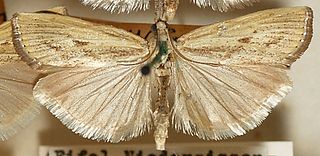
Crambidae comprises the grass moth family of lepidopterans. They are variable in appearance, with the nominal subfamily Crambinae taking up closely folded postures on grass stems where they are inconspicuous, while other subfamilies include brightly coloured and patterned insects that rest in wing-spread attitudes.

The Pyralidae, commonly called pyralid moths, snout moths or grass moths, are a family of Lepidoptera in the ditrysian superfamily Pyraloidea. In many classifications, the grass moths (Crambidae) are included in the Pyralidae as a subfamily, making the combined group one of the largest families in the Lepidoptera. The latest review by Eugene G. Munroe and Maria Alma Solis retain the Crambidae as a full family of Pyraloidea.

Agriphila inquinatella is a small moth species of the family Crambidae. It is found in Europe, around the Caucasus area to Turkestan, and in the Near East to Jordan. The type locality is in Austria.

Cataclysta lemnata, the small china-mark, is a moth species of the family Crambidae. It is found in Europe, Morocco and Iran.

Nomophila noctuella, the rush veneer, is a species of moth of the family Crambidae.

Platytes alpinella is a species of moth of the family Crambidae described by Jacob Hübner in 1813. It is found in Europe, the area surrounding the Caucasus and the eastern part of Russia.
Udea cyanalis is a species of moth in the family Crambidae described by Jean Jacques Charles de La Harpe in 1855. It is found in Portugal, Spain, France, Germany, Switzerland, Austria, Italy, Bosnia and Herzegovina and Romania. It is also found in Russia and Hebei, China.

Pediasia contaminella is a species of moth in the family Crambidae described by Jacob Hübner in 1796. It is found in almost all of Europe, Asia Minor, the Caucasus, Transcaucasia, Iraq, Iran, the Kopet Dagh and Minusinsk.

Pediasia luteella is a species of moth in the family Crambidae. It was described by Michael Denis and Ignaz Schiffermüller in 1775. It is found in most of Europe. In the east, the range extends to Central Asia, the northern Caucasus, Transcaucasia, southern Siberia and Mongolia.
Catoptria caucasicus is a species of moth in the family Crambidae described by Sergei Alphéraky in 1876. It is found in the northern Caucasus.

Catoptria laevigatellus is a species of moth in the family Crambidae described by Julius Lederer. It is found in Bulgaria, the Caucasus, Dagestan, Transcaucasia, Armenia, north-eastern Turkey and Syria.
Catoptria languidellus is a species of moth in the family Crambidae described by Philipp Christoph Zeller in 1863. It is found in Italy, Switzerland, Austria, the Balkan Peninsula, the Caucasus, Transcaucasia, Armenia and Central Asia.

Catoptria mytilella is a species of moth in the family Crambidae described by Jacob Hübner in 1805. It is found in large parts of Europe, Asia Minor and the northern Caucasus.

Evergestis infirmalis is a species of moth in the family Crambidae. It is found in Greece, European Russia, Northeast Caucasus, Turkey and Syria.

Heliothela wulfeniana is a species of moth in the family Crambidae first described by Giovanni Antonio Scopoli in 1763.
Catoptria profluxella is a moth in the family Crambidae. It was described by Hugo Theodor Christoph in 1887. It is found in Transcaucasia and the northern Caucasus.
Loxostege leucalis is a moth in the family Crambidae. It was described by George Hampson in 1900. It is found in the Caucasus.

Pyrausta tithonialis is a moth in the family Crambidae. It was described by Zeller in 1872. It is found in Russia, China, Korea and Japan.
Udea cretacea is a moth in the family Crambidae. It was described by Ivan Nikolayevich Filipjev in 1925. It is found in Georgia and Russia (Caucasus).








